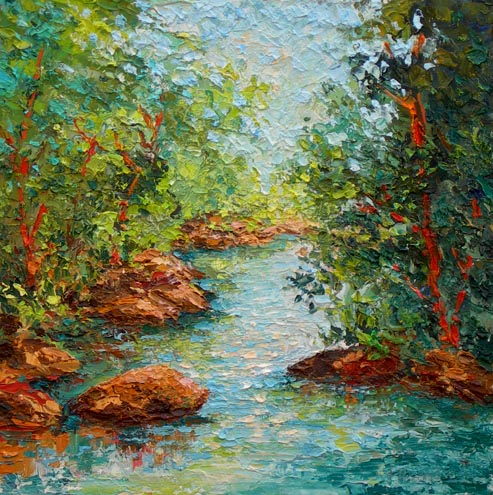Summer is the time to perfect your skills with mixing green colors with the paint of your choice. Whether you work in watercolor, oils, acrylics and even encaustic, the pigments are the same, and ways to mix different hues are the same too.
Here in the mountains of WNC, we live surrounded with green from the tiniest blades of grass to the tops of the tallest trees. All the subtle hues are not possible to mimic from a few tubes of premixed green paints. To really get into the subtleties that the summer landscape reveals, a simplified selection of colors will not fail to produce an endless range of greens.
Stick with a red/yellow/blue selection of colors and get rid of most of the tubes of green paint. A good primary palette of pigments will help you make many green hues for all seasons! Always use a limited palette, and you will never go wrong. For each primary choose an opaque and transparent pigment for more versatility.
Tubed greens are mostly mixes of pigments, and do not give you a variety of greens. Steer clear of phthalo blue and phthalo green if you want a more natural look. Most green mixes contain this pigment. It is a bully and hard to tame. It is great if you want a POP ART look though, so consider your style and the outcome you desire. Mix your own and you can create anything!
Learn to read the labels on your paint tubes so you will be sure what you are using. You can find lots of info about what all the codes on the tubes mean online or in color charts provided by many paint companies.
To make a beautiful lime green, mix cobalt teal with a light cadmium yellow or hansa yellow light. This mix is perfect for the new growth colors! Blue Ridge Oil Paints - made in Asheville, NC by Eric Silver - has this perfect pigment made with real cobalt. Gamblin is another good American made company that makes a great cobalt teal. For acrylic painters who cannot find a real cobalt teal, substitute cerulean blue (cobalt kind).
Try a darker, more orange yellow, such as cadmium yellow dark, mixed with ultramarine blue to achieve a more forest green that pushes a bit toward brown, great for old forests and undergrowth. Add more blue and a touch of red (with no white added) for the deep shadows in the trees and grasses.
For a softer, but still true green, try cerulean blue (also perfect blue for skies) with a light lemon yellow – hansa or cadmium. To vary a bit, mix the cerulean with a medium or dark yellow and see what you get.
To the above mixture add some white and just a tiny touch of cadmium red light or medium red. You will create a beautiful soft sage green. Amazing!
Try some Indian yellow with different blues for new mixes. Use this yellow also for fields of grain and hay. This is a strong pigment, and transparent so can be useful for glazes too. Other tubed greens that can add to your palette successfully are cobalt green (try Blue Ridge Oil Paints) and a true viridian (not a phthalo mix) available in oils. Almost everything in acrylic is a mixed pigment, usually containing phthalocyanine, so just mix your own greens! Golden Acrylics has cobalt turquoise, but no longer makes cobalt teal I am sorry to say.
This should keep you busy for a while painting gorgeous summer landscapes!


